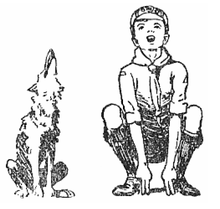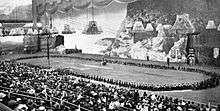Grand Howl

The Grand Howl is a ceremony used by Cub Scouts. It was devised by Robert Baden-Powell and is based on the Mowgli stories in Rudyard Kipling's Jungle Book. In the ceremony, Cubs act out the wolves greeting Akela, the "Old Wolf" at the Council Rock and are reminded of the Cub Scout Promise. Baden-Powell also created a Grand Howl for Brownie Guides, which was in imitation of an owl instead of a wolf.
Origin
Five years after the founding of the Scout movement, Baden-Powell and others worked on a scheme for those who were too young to join the Boy Scouts at the age of 11, initially called "Junior Scouts". By the time of the launch of the scheme, Baden-Powell had obtained the approval of his friend and neighbor, Rudyard Kipling, to use the Jungle Book as a theme. Under the name of "Wolf Cubs", the 8- to 10-year-old boys would take part in basic versions of the activities enjoyed by the older Boy Scouts, but within a background of the jungle in the Mowgli stories of Kipling's 1898 book. The Cubs would act out scenes from the stories, and the adult leaders would adopt the names of characters from the book, the leader in charge being Akela, who had been the head of the wolf pack.
Baden-Powell wrote a book to accompany the launch of the new section of the movement; The Wolf Cub's Handbook was published on 2 December 1916. In the first chapter, he describes how in the Jungle Book, "The wolves all sat round the council rock in a circle, and when Akela, the old wolf, the head of the pack, took his place on the rock, they all threw up their heads and howled their greeting to him." Baden-Powell continued; "When your Old Wolf, Akela - that is your Cubmaster or other Scouter - comes to your meeting you salute him by squatting round in a circle as young wolves do, and giving him the Wolf Cub Grand Howl".[1]
The Original Grand Howl

The original instructions for the Grand Howl, described by Baden-Powell in The Wolf Cub's Handbook.
- Scouter: "Pack - Pack - Pack!" This calls the Cubs into a Parade Circle.
The Cubs reply as they run to their places in the circle.
- Cubs: "Pack!"
As the Scouter enters the circle, the Cubs squat down on their heels with their "fore paws" on the ground between their feet and their knees out on either side.
- Cubs: "Ah-kay-la! We-e-e-e-ll do-o-o-o o-o-o-u-u-r BEST!" On the word "BEST", the Cubs jump to their feet with two fingers of each hand at the sides of their heads, to resemble a wolf's ears.
- A Sixer: "Dyb - dyb - dyb -dyb" The word "dyb" means "Do Your Best" which is the first part of the Cub Promise and was the original Wolf Cub motto.
On the fourth "dyb", the Cubs lower their left hands and the fingers of their right hands extend to form the Wolf Cub salute.
- Cubs: "We-e-e-e-ll dob-dob-dob-dob", meaning "We'll do our best".[1]
National variants

United Kingdom
In 1966, a complete review of the UK Scout Association, The Chief Scouts' Advance Party Report, recommended that less emphasis be placed on the Jungle Book for Wolf Cubs, who were to be renamed Cub Scouts. Although the Grand Howl was to be retained, it was revised, replacing the "dybs" with plain language to "make the significance clearer to parents and public".[2] The recommendations were accepted and began to be implemented in October 1966.[3] The revised Grand Howl is as follows:
- Pack in circle.
- Cub Scout Leader in centre, arms outstretched facing Sixer;
- Cub Scout Leader arms down;
- Pack squats.
- Pack: "Akela! We'll do our best".
- Sixer: "Cubs! Do your best".
- Cubs: "We will do our best", giving the Scout salute (which had replaced the two-finger salute in the Cub Section).[2]
Following a further programme review between 2000 and 2002, the Grand Howl became optional, allowing Packs to adopt themes other than the Jungle Book.[4]
The independent Baden-Powell Scouts' Association and British Boy Scouts and British Girl Scouts Association continue with the original Grand Howl.[5]
United States
The Cub Scout programme of the Boy Scouts of America uses the traditional Grand Howl as a "special recognition ceremony" with the person being honoured (a guest, parent or member of the Pack), standing in the centre of the circle. In addition, a Short Grand Howl can be used as follows:
- Cubs make the two fingered Cub Scout Sign with both hands, fingertips touching the floor in a squatting position.
- They howl; "Ah-h-kay-y-la! We-e-e'll do-o-o ou-u-r best!"
- As they yell the last word, "best", they jump up with both hands above their heads in the Cub Scouts Sign.[6]
Canada
The Cub Scouts of Scouts Canada use the traditional Grand Howl.[7] The following version is used in French speaking Packs:
- "A-a-a K-é-é La-a,
- "De... no... tre... mieux !"
- "De... vo... tre... mieux !"
- "Oui, de... no... tre... mieux !"[8]
Australia
The Grand Howl used by the Cub Scouts of Scouts Australia is as follows:
- Cubs Scouts: "A-ke-la, we'll do our best".
- Selected Cub Scout: "Do your best".
- Cub Scouts: "We'll do our best".[9]

New Zealand
The Grand Howl used by the Cubs of Scouts New Zealand is identical to the version currently used in the United Kingdom.[10]
Brownies
A junior section of Girl Guides started in 1914 in the United Kingdom, under the name of "Rosebuds"; this name was disliked by girls and it was soon amended to Brownies, being themed on the story by Juliana Ewing.[11] In Baden-Powell's 1918 book, "Girl Guiding: A Handbook for Brownies, Guides and Rangers", the Grand Howl is described as "the grandest salute a Pack (of Brownies) can give, and is only for very special occasions". Baden-Powell describes how the Brownies should begin in a squatting position, in the same way as the Cub equivalent, but repeating "Tu-whit, tu-whit, Tu-whoo-oo" three times, each time getting louder and rising higher, until at the end of the third repetition, the Brownies were to jump in the air and clap their hands above their heads.[12]
In the United Kingdom, the 1966 report called Tomorrow's Guide by a Working Party set up to revise and update the programme of the Girl Guides Association, recommended a reduction in the number of ceremonies used by Brownies;[13] the Grand Howl was not retained. The Brownie Grand Howl is still used by the Girl Guides of Canada.[14]
References
- 1 2 Baden-Powell, Robert (1916). "The Wolf Cub's Handbook" (PDF). www.thedump.scoutscan.com. Arthur C Pearson. Retrieved 24 October 2013. (pp. 12-13)
- 1 2 "The Advance Party Report '66" (PDF). www.thedump.scoutscan.com. The Boy Scouts Association. 1966. Retrieved 24 October 2013. (p. 20)
- ↑ "Design for Scouting" (PDF). www.thedump.scoutscan.com. The Boy Scouts Association. 1967. Retrieved 24 October 2013.
- ↑ "Cub Scout Leader Start-up Kit" (PDF). www.1stcoggeshall.org.uk. The Scout Association. Retrieved 24 October 2013. (p. 14)
- ↑ "2nd Goring and Streatley Wolf Cubs - Ceremonies". 2ndgoringandstreatley.org.uk. Retrieved 26 October 2013.
- ↑ "Den Chief Handbook, ISBN 0-8395-3211-3" (PDF). /www.greystonecubs.com. Boy Scouts of America. 2004. Retrieved 26 October 2013. (pp. 79-80)
- ↑ "Cub Leader's Handbook: Chapter Five - Ceremonies" (PDF). wiki.scouts.ca. Scouts Canada. Retrieved 26 October 2013. (p. 4)
- ↑ "Fais le Grand Hurlement avec les autres louveteaux" (PDF). scoutsndip.ca. Scouts Canada. Retrieved 26 October 2013.
- ↑ "The Grand Howl" (PDF). scouts.org.au. The Scout Association of Australia. Retrieved 26 October 2013.
- ↑ "New Cubs Investiture Booklet" (PDF). smartscouts.co.nz. Scouts New Zealand. Retrieved 26 October 2013. (pp. 8-9)
- ↑ "Leslie's Guiding History Site - Brownies". lesliesguidinghistory.webs.com. Retrieved 2 November 2013.
- ↑ Baden-Powell, Robert (1918). "Girl Guiding" (PDF). www.thedump.scoutscan.com. Arthur C Pearson. Retrieved 2 November 2013. (p. 14)
- ↑ "Leslie's Guiding History Site - Brownies". lesliesguidinghistory.webs.com. Retrieved 5 November 2013.
- ↑ "The Brownie Program In a Nutshell" (PDF). http://www.girlguides.sk.ca. Girl Guides of Canada, Saskatchewan Council. Retrieved 7 November 2013. External link in
|website=(help)